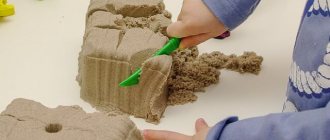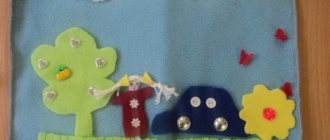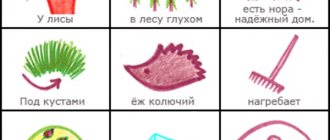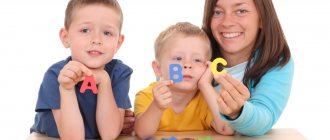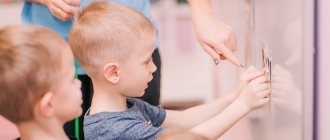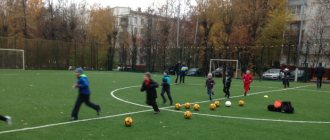Sensory abilities are manifested in a particularly sensitive perception of the properties and relationships of objects and phenomena in the surrounding world. Actions aimed at the perception and cognition of various objects can provide both superficial information and can reveal multifaceted knowledge about the properties and connections of these objects. It all depends on the abilities of the perceiver.
The sensory abilities of preschoolers are at the initial stage, as, in fact, is all mental development at this age. It is important to stimulate the formation of these abilities in order to provide the child with full-fledged conditions for entering the real world.
Features of the formation of children's sensory abilities
The development of a child’s perception, in essence, is a process of formation and improvement of perceptual actions. In childhood, perceptual actions are the main providers of information that help the child navigate a multifaceted and still completely unknown environment. That’s why children want to touch and even taste everything.
Sensory abilities are part of cognitive abilities. The preschooler is extremely inquisitive, and he acts as much as his physical capabilities allow.
Practice puts forward specific tasks for the child’s perception - observing, lifting, pulling through a hole, matching by color, hearing a certain sound and similar exercises, the implementation of which occurs thanks to the sensory functions of the body.
Even when a child acts spontaneously, without any outside promptings, he not only accumulates experience in perceptual operations, but also draws certain conclusions. For example, a tomato is similar to an apple, but its taste is different; the ball fits into one bucket, but not into the other; For some reason mom’s bag won’t lift...
The baby needs certain basic information that would serve as a measure for new information coming to him. And this perceptual base is slowly accumulating. It has its own scientific name - sensory standards. Of course, they are not “implanted” in the child’s brain overnight. Standards are gradually collected in the treasury of children's consciousness, going through the natural path of formatting. The more standards (measures, samples) are fixed in the cognitive experience of a preschooler, the easier it will be for him to assimilate new information.
Sensory standards in preschool age
Standards of perception, before becoming established and acquiring clear boundaries, pass through the stage of pre-standards in childhood development.
It is impossible to list all sensory standards; let us note some of the most important of them:
- forms
- colors
- size
- volume
- smoothness
- hardness
- distances, etc.
The formation of each standard requires its own time interval. For example, how does a child perceive color? The first ones he begins to highlight are red, yellow, and green. Shades are not yet differentiated by the child’s visual perception.
For example, a younger preschooler perceives cherry and pink as red. Only after a certain time, after adults several times show the child objects of the corresponding color (cherry, bow, cherry-colored socks), this shade in the child’s understanding will first stand out as different from red, and then be remembered by its name.
The main condition for the formation of sensory reference representations in preschool age is the ability to conduct a perceptual examination by the child of those properties of objects that should become reference.
That is, a preschooler must examine or turn an object in his hands in order to understand its shape; touch or squeeze several toys to feel hardness or elasticity, listen to similar sounds to highlight sonority, etc.
It is especially difficult to form such a sensory standard as quantity. If a child looks at objects in reality, then already at 3 years old he will determine which one is large and which one is small. But, if a preschooler looks at the images, it is difficult for him to understand which object is larger.
Test. To check at what stage of formation the pre-standard value is, show the preschooler a drawing that shows a one-story house in the foreground, and a multi-story house in the distance.
Ask your child which of these houses is bigger. If a child points to a smaller image and explains that this house is larger because it has floors, it means that he is already taking perspective into account in his perception of size. This indicates the formation of this sensory standard. If the answer is different, children are guided by absolute sizes, which corresponds to the initial stage of the formation of the perception of size.
Of course, children with pronounced sensory abilities will quickly master spatial orientation. Already at 4-5 years old they adequately assess the real shape and size of images. And other sensory standards will take their full place in the perception of a capable child earlier than in other children.
Sensory education – what is it?
Sensory education of children, as defined in textbooks and manuals, means the development of perception of various phenomena of the surrounding world and the sensations that arise, understanding their meaning and properties, the formation of ideas about certain objects and their differentiation. Improving sensory abilities is directly related to the mental and intellectual level of the child. Therefore, sensory education is also used as one of the methods for treating problem children with delayed development of any age. The sensory system of every healthy, fully developed person consists of five aspects of perception: touch, smell, vision, hearing and taste. If we talk about sensory perception, then there are generally accepted standards that must be learned from an early age: geometric shapes, sizes, primary colors of the spectrum, etc. This is exactly what sensory exercises for children are aimed at.
Development of sensory abilities in the activities of preschool children
Productive activities provide favorable conditions for the development of sensory abilities in preschool childhood. Drawing, designing, modeling, making appliques - all these activities help the child not only notice certain properties and relationships of objects, but also provide the opportunity to apply and feel them through the materials used.
It is important not so much to master a sensory standard as to learn to relate it, as a measure, to a specific object or phenomenon in different conditions.
Where else can one acquire information about shape and size if not in constructive activities? A preschooler builds towers and bridges, trying on parts of construction sets; assembles puzzles, looking for suitable protrusions and holes; tightens nuts, connecting parts of metal and wooden construction sets. Only in such real practice do sensory abilities associated with visual and tactile receptors develop.
Games with clothespins
Clothespins are an accessible material for developing fine motor skills. To attach or unhook a clothespin, the child uses his fingers and practices exciting movements. Children under 2 years old use their entire hand to grasp, and games with clothespins will help coordinate the precise work of their fingers. Thanks to the color scheme of clothespins, you can study colors and form mathematical concepts.
Games with clothespins develop fine motor skills.
Using your imagination, you can offer your child many options for games with clothespins, including:
- Wash. Stretch a rope between two chairs and offer to hang the doll's clothes on it, securing with clothespins.
- Constructor. Using clothespins, three-dimensional figures, robots, animals, and vehicles are created.
- In the animal world. Print figurines of hedgehogs and bunnies. Attach needles in the form of clothespins to the hedgehog, and make ears out of them for the bunny.
- Polyanka. Cut out the sun, cloud, grass, tree from colored cardboard. The child attaches clothespins of the appropriate color to the stencil to create a three-dimensional picture.
- Who eats what? Print out the faces of different animals and the food they prefer. Cut a circle out of cardboard and divide it into sectors. Stick a picture of food on each one. Glue the faces onto the clothespins with tape. The child attaches clothespins with animals to the sector where suitable food is depicted.
DIY didactic games
Didactic educational games do not have to be purchased in a specialized store. You can create them yourself and involve your child in the process. This will make him want to learn new things while playing. Household items that a person encounters every day are suitable as equipment. This will introduce the preschooler to everyday objects and avoid additional cash expenses.
Finger dry pool
Dry pool is a game for the development of fine motor skills, which includes finger gymnastics. Fill a deep bowl 12-15 cm high halfway with dry peas. The child dips his hands into the filler, sorts out the peas, and scatters them. In this way, self-massage of the fingers occurs.
Games in a dry pool are accompanied by music or poetry. You can put small toys at the bottom of the bowl, which you need to find and describe with your eyes closed. The game is suitable for children two to three years old.
Salt dough beads game
Children are invited to create beads as a gift for their mother from multi-colored rings. The teacher makes salt dough rings in advance and dries them in the oven. You can buy the dough at the store or make it yourself. For this you will need:
In the salt dough beads game, children string beads onto a string.
- flour - 1 glass;
- salt - 1 glass;
- starch - 1 tbsp. l.;
- water - 1 ½ cups;
- colored gouache.
Dilute starch in ½ glass of cold water, pour 1 glass of boiling water. Mix half a glass of the resulting solution with flour and salt. Knead the dough, paint it in different colors. Form rings.
During the lesson, children string beads onto a cord and form a decoration.
Guide “put the eggs in your houses”
The teacher paints a cardboard container for eggs in 4 colors: red, blue, green, yellow. Boxes of chocolate eggs (kinder surprise) are covered with appropriate colored paper. Children place colorful eggs into the appropriate cells.
"Tactile Box"
The basis of the interactive manual is a box, a saucepan, and a plastic container with a lid. It is filled with natural materials (cereals, sand, flour, shells, stones, leaves). You can add paper, cotton wool, fabric, toys to the box. The box is supplemented with tools - a spoon, spatula, glasses, muffin tins. The child studies the contents of the box, learns to manipulate different objects, and becomes familiar with various tactile sensations. You can play with the contents of the box according to the instructions of an adult or leave room for the free creativity of a preschooler.
Game "colorful sticks"
Colored counting sticks - Cuisenaire's manual. It is a set of 116 plastic sticks in 10 different colors and sizes. The smallest stick is 10 mm long, the next ones increase by 10 mm. Sticks of the same length are colored the same. Using the manual allows children to develop their understanding of numbers based on counting and measurement, form spatial concepts, and study the “more-less” relationship. You can make your own sticks or buy them at the store.
Wonderful pouch
To play you will need a large thick fabric bag and various small objects: pebbles, figures, balls and beads, coins, fabric, cones. During the game, tactile perception develops. Children take turns putting their hand into the bag and describing the object they felt. The task is to guess what item is in the bag. The lesson is carried out both individually and in a group in kindergarten.
Constructor
Construction is an activity that is aimed at creating new objects from small parts. By assembling the details of the construction set, the child develops imagination, fine motor skills, thinking, and studies colors and shapes.
An adult can offer to assemble a figure according to a model, give an oral task, or allow the child to experiment.
"Spider in the Clearing"
To play, you will need a plastic transparent bucket with a lid; holes are made in it for lacing and attaching additional parts. A spider is glued to a lid made of colored paper. The eyes are made from plastic bottle caps, painted in suitable colors, and connected to the base. Laces are added to the paws and inserted into the holes. From them the child “weaves a web.”
Small objects and ribbons are placed in the bucket, which can be pushed through holes of different diameters. There are many options for manipulating the manual, so children will come up with a new game with the spider every time.
